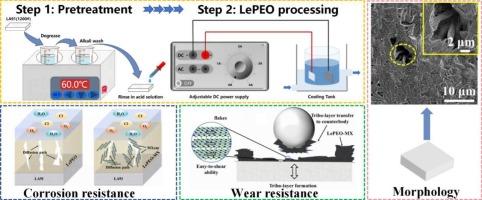Effect of introduction of MXene on low energy plasma electrolytic oxidation
IF 5.3
2区 材料科学
Q1 MATERIALS SCIENCE, COATINGS & FILMS
引用次数: 0
Abstract
This article discusses the development of 2D MXene-containing coatings on magnesium alloy LA91, which are produced using low-energy plasma electrolytic oxidation (LePEO) processing. The coatings enhance substrate corrosion resistance and offer improved wear resistance. Notably, the coatings exhibit increased corrosion and wear resistance, as well as higher microhardness, while simultaneously reducing the voltage required for the PEO process. The addition of MXene to electrolyte enhances its conductivity, leading to the incorporation of MXene into the oxide coating. Despite a reduction in coating thickness, the resulting coatings demonstrate excellent corrosion resistance, wear resistance, and hardness. The MXene-enriched PEO coatings show impressive performance metrics compared to the Mg![]() Li alloy substrate. The corrosion current density of the MXene-enriched coatings is only 3.3 % of that of the Mg
Li alloy substrate. The corrosion current density of the MXene-enriched coatings is only 3.3 % of that of the Mg![]() Li alloy, while the average friction coefficient is reduced to 39.9 %, and the hardness is 6.6 times greater. Additionally, the coatings exhibit enduring corrosion resistance during prolonged immersion and neutral salt spraying tests. These performance improvements are attributed to MXene's ability to hinder the transmission of corrosive media, as well as its interlayer shear and self-lubrication properties, which enhance wear resistance.
Li alloy, while the average friction coefficient is reduced to 39.9 %, and the hardness is 6.6 times greater. Additionally, the coatings exhibit enduring corrosion resistance during prolonged immersion and neutral salt spraying tests. These performance improvements are attributed to MXene's ability to hinder the transmission of corrosive media, as well as its interlayer shear and self-lubrication properties, which enhance wear resistance.

引入 MXene 对低能等离子体电解氧化的影响
本文讨论了在镁合金 LA91 上使用低能等离子电解氧化(LePEO)工艺生产的二维含氧化镁涂层的开发情况。涂层增强了基体的耐腐蚀性,并提高了耐磨性。值得注意的是,在降低等离子电解氧化工艺所需电压的同时,涂层还表现出更强的耐腐蚀性和耐磨性,以及更高的微硬度。在电解液中加入 MXene 可增强其导电性,从而使 MXene 融入氧化物涂层中。尽管涂层厚度有所减少,但所得到的涂层仍具有出色的耐腐蚀性、耐磨性和硬度。与镁锂合金基材相比,富含 MXene 的 PEO 涂层显示出令人印象深刻的性能指标。富含 MXene 的涂层的腐蚀电流密度仅为 MgLi 合金的 3.3%,而平均摩擦系数则降低到 39.9%,硬度是后者的 6.6 倍。此外,涂层在长时间浸泡和中性盐喷试验中表现出持久的耐腐蚀性。这些性能的提高归功于 MXene 能够阻止腐蚀性介质的传播,以及其层间剪切和自润滑特性,从而增强了耐磨性。
本文章由计算机程序翻译,如有差异,请以英文原文为准。
求助全文
约1分钟内获得全文
求助全文
来源期刊

Surface & Coatings Technology
工程技术-材料科学:膜
CiteScore
10.00
自引率
11.10%
发文量
921
审稿时长
19 days
期刊介绍:
Surface and Coatings Technology is an international archival journal publishing scientific papers on significant developments in surface and interface engineering to modify and improve the surface properties of materials for protection in demanding contact conditions or aggressive environments, or for enhanced functional performance. Contributions range from original scientific articles concerned with fundamental and applied aspects of research or direct applications of metallic, inorganic, organic and composite coatings, to invited reviews of current technology in specific areas. Papers submitted to this journal are expected to be in line with the following aspects in processes, and properties/performance:
A. Processes: Physical and chemical vapour deposition techniques, thermal and plasma spraying, surface modification by directed energy techniques such as ion, electron and laser beams, thermo-chemical treatment, wet chemical and electrochemical processes such as plating, sol-gel coating, anodization, plasma electrolytic oxidation, etc., but excluding painting.
B. Properties/performance: friction performance, wear resistance (e.g., abrasion, erosion, fretting, etc), corrosion and oxidation resistance, thermal protection, diffusion resistance, hydrophilicity/hydrophobicity, and properties relevant to smart materials behaviour and enhanced multifunctional performance for environmental, energy and medical applications, but excluding device aspects.
 求助内容:
求助内容: 应助结果提醒方式:
应助结果提醒方式:


